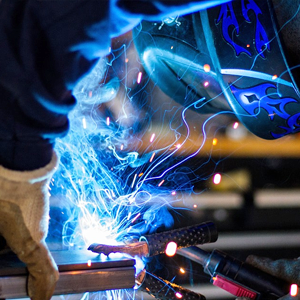Strong supports are fabricated from stainless steel because this material is incredibly robust. The beams are tough, corrosion-resistant, and guaranteed not to deform when a structure reaches great heights. Again, this is a robust alloy, but what joins one ferrous metal part to its neighbor? What creates a union between the fabricated parts that’s as strong as the material’s metallic base? That’s a job for the most common processes used in the welding of stainless steel, a task that calls for arc welding know-how.
Arc Welding: An Overview
An electrically generated “arc” creates great quantities of thermal energy at the terminating end of an expertly wielded electrode. As the bright electrical spark closes in on the join zone, the steel melts, flows, and fuses. The intermixed weld then cools to form a hardened joint between the two stainless steel parts.
Gas Tungsten Arc Welding
In this metal bonding variant, a tungsten electrode produces the necessary thermal energy. It works in tandem with an inert gas to achieve full weld flow. The addition of argon is employed as a shielding mechanism, a means of stopping oxygen from corrupting the weld.
Plasma Arc Welding
Intended as a derivative of the above method, the plasma technique adds a specially extruded nozzle to the welding equipment. This special tip focuses the arc into a plasma stream, a heat source that penetrates deeper than the gas tungsten arc. Again, this is a high-integrity fusion process, but it delivers more penetration due to its constricted electrode profile.
Shielded Metal Arc
As the label suggests, the electrode is covered when this welding technique is active. Weld joint success relies on the energy arcing between the flux and the workpiece. The consumable flux appears very much like a thin stick of ignitable material. It brushes against the weld area to form a bright spark and targeted heat. The so-called “stick” melts with the steel to form a filler pool, so the weld is receiving a high-deposition fillet, something that will increase the strength of the cooling weld seam.
Numerous supplementary arc welding methods exist in industry. They include submerged arc welding and gas metal arc welding equipment, but their goal is always to cause fusion through resistive current flow. Variations on the theme add inert gasses and filler metals. Then, beyond these methods, there’s mass production-friendly electric resistive welders and contact-less laser welders, the gear that rapidly spits out welded car chassis’ and countless other stainless steel products.
